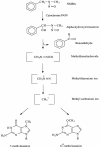Chemoprevention of esophageal squamous cell carcinoma
- PMID: 17475300
- PMCID: PMC2128258
- DOI: 10.1016/j.taap.2007.01.030
Chemoprevention of esophageal squamous cell carcinoma
Abstract
Esophageal squamous cell carcinoma (SCC) is responsible for approximately one-sixth of all cancer-related mortality worldwide. This malignancy has a multifactorial etiology involving several environmental, dietary and genetic factors. Since esophageal cancer has often metastasized at the time of diagnosis, current treatment modalities offer poor survival and cure rates. Chemoprevention offers a viable alternative that could well be effective against the disease. Clinical investigations have shown that primary chemoprevention of this disease is feasible if potent inhibitory agents are identified. The Fischer 344 (F-344) rat model of esophageal SCC has been used extensively to investigate the biology of the disease, and to identify chemopreventive agents that could be useful in human trials. Multiple compounds that inhibit tumor initiation by esophageal carcinogens have been identified using this model. These include several isothiocyanates, diallyl sulfide and polyphenolic compounds. These compounds influence the metabolic activation of esophageal carcinogens resulting in reduced genetic (DNA) damage. Recently, a few agents have been shown to inhibit the progression of preneoplastic lesions in the rat esophagus into tumors. These agents include inhibitors of inducible nitric oxide synthase (iNOS), cyclooxygenase-2 (COX-2), vascular endothelial growth factor (VEGF) and c-Jun [a component of activator protein-1 (AP-1)]. Using a food-based approach to cancer prevention, we have shown that freeze-dried berry preparations inhibit both the initiation and promotion/progression stages of esophageal SCC in F-344 rats. These observations have led to a clinical trial in China to evaluate the ability of freeze-dried strawberries to influence the progression of esophageal dysplasia to SCC.
Figures






Similar articles
-
Etiology and chemoprevention of esophageal squamous cell carcinoma.Carcinogenesis. 2001 Nov;22(11):1737-46. doi: 10.1093/carcin/22.11.1737. Carcinogenesis. 2001. PMID: 11698334 Review.
-
Chemoprevention of esophageal squamous cell carcinoma with berries.Top Curr Chem. 2013;329:1-20. doi: 10.1007/128_2012_343. Top Curr Chem. 2013. PMID: 22752584 Review.
-
[Natural compounds in chemoprevention of esophageal squamous cell tumors--experimental studies].Pol Merkur Lekarski. 2009 Feb;26(152):156-61. Pol Merkur Lekarski. 2009. PMID: 19388525 Review. Polish.
-
Clinical models of chemoprevention for the esophagus.Hematol Oncol Clin North Am. 1998 Oct;12(5):1055-77. doi: 10.1016/s0889-8588(05)70041-1. Hematol Oncol Clin North Am. 1998. PMID: 9888021 Review.
-
Randomized phase II trial of lyophilized strawberries in patients with dysplastic precancerous lesions of the esophagus.Cancer Prev Res (Phila). 2012 Jan;5(1):41-50. doi: 10.1158/1940-6207.CAPR-11-0469. Epub 2011 Dec 1. Cancer Prev Res (Phila). 2012. PMID: 22135048 Free PMC article. Clinical Trial.
Cited by
-
Elevated serum levels of human relaxin-2 in patients with esophageal squamous cell carcinoma.World J Gastroenterol. 2013 Apr 21;19(15):2412-8. doi: 10.3748/wjg.v19.i15.2412. World J Gastroenterol. 2013. PMID: 23613637 Free PMC article.
-
Tolfenamic acid suppresses cytochrome P450 2E1 expression in mouse liver.Integr Biol (Camb). 2012 Sep;4(9):1122-9. doi: 10.1039/c2ib20127e. Epub 2012 Jul 26. Integr Biol (Camb). 2012. PMID: 22832660 Free PMC article.
-
Inhibition of the development of N-nitrosomethylbenzylamine-induced esophageal tumors in rats by strawberries and aspirin, alone and in combination.J Berry Res. 2018;8(2):137-146. doi: 10.3233/JBR-170291. Epub 2018 May 17. J Berry Res. 2018. PMID: 29977412 Free PMC article.
-
Synergism of Fusobacterium periodonticum and N-nitrosamines promote the formation of EMT subtypes in ESCC by modulating Wnt3a palmitoylation.Gut Microbes. 2024 Jan-Dec;16(1):2391521. doi: 10.1080/19490976.2024.2391521. Epub 2024 Aug 28. Gut Microbes. 2024. PMID: 39193618 Free PMC article.
-
Chemoprevention of gastrointestinal cancer: the reality and the dream.Gut Liver. 2013 Mar;7(2):137-49. doi: 10.5009/gnl.2013.7.2.137. Epub 2013 Feb 7. Gut Liver. 2013. PMID: 23560148 Free PMC article.
References
-
- Anani PA, Gardiol D, Savary M, Monnier P. An extensive morphological and comparative study of clinically early and obvious squamous cell carcinoma of the esophagus. Pathol. Res. Pract. 1991;187:214–219. - PubMed
-
- Ando T, Ishiguro H, Kimura M, Mitsui A, Kurehara H, Sugito N, Tomoda K, Mori R, Takashima N, Ogawa R, Fujii Y, Kuwabara Y. Decreased expression of NDRG1 is correlated with tumor progression and poor prognosis in patients with esophageal squamous cell carcinoma. Dis Esophagus. 2006;19:454–458. - PubMed
Publication types
MeSH terms
Substances
Grants and funding
LinkOut - more resources
Full Text Sources
Medical
Research Materials
Miscellaneous

